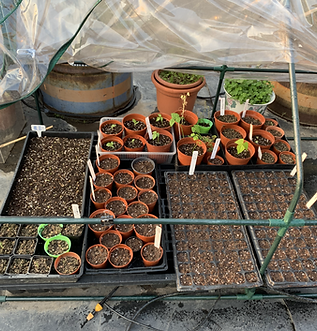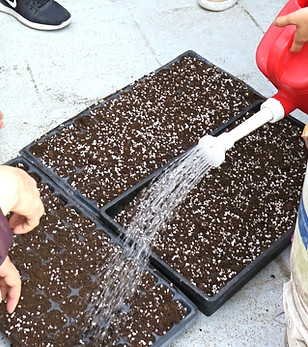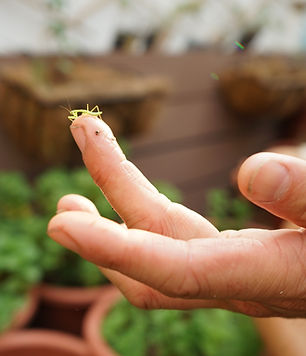
An urban edible space by definition is a place for growing food! We believe that growing food, rather than other ornamental plants, can generate much more conversations on health and wellbeing, connection with nature, sustainability and more. In this section, we will give you some tips to decide what to grow and how to grow at your urban edible space. You can decide what to grow according to the time, the space and resources you have and the community you serve.
Start to grow!

What to grow...
Many herbs species are relatively easy to grow and maintain, can be grown with smaller soil volume, and are less susceptible to pest problems. There are mainly three varieties of herbs according to their origin, the Mediterranean herbs (e.g. rosemary and thyme) which prefer well-draining soil and dislike high humidity, tropical herbs (e.g. basil) which thrive in warm weather, and Asian herbs (e.g. perilla) that adapts well to local climate. For mobile viewing, please click here to see the following table.
Herbs
There are mainly three categories of edible plants that you can grow at your edible garden or farm: vegetables, herbs and fruit trees. While each variety of crop has different requirements and benefits, in general, herbs are relatively easiest to start with, whereas vegetables are more advanced. As for fruit trees, due to the high requirements on soil volume and growing time, it is less suitable for urban edible spaces. Here is an overview of what herbs and vegetables you can grow at your space and their respective requirements.
Vegetables
Although 90% of the food supply in Hong Kong is imported, there are over 100 crops suitable for growing in Hong Kong's climate, and majority of them are vegetables. Compared to herbs, growing vegetables may be more challenging and requires higher levels of input such as manpower, watering, fertilisation, pest control etc. It is important for us to grow according to the local climate and seasons to maximise our harvest while minimising harm to the soil and nature by applying too much fertilisers and pesticides. For mobile viewing, please click here to see the following table.
Variety
Lettuce
White Radish
Tomato
Cucumber
Sweet Potato
Chinese
Chives
Corn
Difficulty
Sunlight
requirement
Water
requirement
Planting
month
Late Aug -Feb
Early sowing:
Late Aug - Sept
Late sowing:
Oct - Nov
Late Aug -
Feb
Late Feb - Aug
Mar-Aug
Jan - Dec
Late Feb - Apr
Late Aug - Sept
Growth
period
60-70 days
70-110 days
90-120
days
50-70 days
120-180
days
Perenial
(Harvest every
50-70 days)
70-80 days
Soil depth
10-15cm
30-45cm
25-35cm
15-20cm
10-15cm
25-35cm
25-35cm
10-15cm
Planting distance
20-35cm
30-60cm
40-50cm
30-50cm
20-30cm
30-40cm
How to grow...
Throughout the years, HKU has been practising sustainable farming on the campus edible spaces, making the space a great platform for sustainability education. While conventional farming puts agricultural productivity and profitability at its centre, sustainable farming takes environmental and social considerations into account, it works with, rather than against nature. In the following section, you can find out how to set up your own edible space with tips on adopting sustainable farming principles.
1. Soil preparation
Good quality soil can help you grow strong and healthy plants, it provides major nutrients to your plants and also help to retain and drain excess water. There is a large variety of premixed potting soil available in gardening shops, but be sure to check whether it is suitable for growing edible plants. Some soil mix for growing ornamental plants or flowers have chemical ingredients that may not be suitable for growing food.
Generally, a good soil mix include the following ingredients: peat moss, coconut coir, perlite, vermiculite and compost as the base fertiliser, the ideal ratio is 3: 2: 1: 1: 1. You can also buy these components separately and mix the soil yourself.


2. Container
Generally, the choice of the container is often determined by the variety of the crop you are growing, especially the soil volume needed for its roots system. Shallow root crops like leaf vegetables require soil depth of around 13-18cm, while deep root crops like melons and fruits, should be grown in containers with at least 38cm depth. The planters should also have a good drainage.
The width of a planter box should be between 40-100cm, and the depth should be around 32-38cm. The soil level should reach around 80% of the height of the box so the soil depth is around 25-30cm. Before pouring the soil, you can use a mesh cloth to pad the bottom of the box to prevent the soil running off and stop insects from entering from the ground.
3. Sowing
When buying seeds, remember to pick those that are produced locally or regionally so that your crops can survive in the local climate. Sow your seeds only in the right seasons to ensure your plants can grow in suitable conditions, usually there are relevant information on the seed packagings. Some varieties of crops can be directly sown in the place where it will grow while some can be raised in a more protected nursery before transplanting to a bigger container or area. For instance, when growing leafy vegetables like lettuce and spinach, you can start by scattering the seeds evenly on a nursery tray and covering with a thin layer of soil. When the seedlings have grown, you can thin them out and transplant them to bigger area with wider spacing. For bigger crops like corn and okra, you can sow the seeds in holes with suitable distance apart from each other, and cover the seeds with soil. The germination rate of seeds is normally 60%-80%, so it is smart to plant more seeds to ensure a higher success rate.


4. Watering
Watering properly is essential to plant growth. Too little water can cause the plant to die in dryness or turn weak, too much water can also cause the roots to rot. You can always use your hands or a spade to check the moisture of the soil, watering is needed when the soil is dry! Here are several tips on watering.
-
Avoid watering during the hottest or coldest times of the day
-
Water on the soil and avoid splashing water all over the plant as water is mainly absorbed through the roots (for some plants, watering on leaves may promote fungus and disease)
-
Water gently and slowly so as to not damage the plant and allow the soil to absorb the water
In addition, you can apply a layer of mulch such as dried leaves on the soil surface to reduce surface runoff and evaporation.
5. Fertilising
Avoiding the application of chemical fertilisers is one major element of organic farming to avoid environmental pollution and harm to human health. There are some organic fertilisers that we can use to help maintain well-balanced soil:
-
Peanut meal: Rich in nitrogen (N) which promotes leaf growth
-
Bone meal: Rich in phosphorus (P) which promotes root growth and flowering
-
Plant ash: Rich in potassium (K) that helps plant synthesise carbohydrates and regulate metabolic activities
Some commonly found household waste like coffee grounds and eggshells can also be used as fertiliser. Food scraps and garden waste can be used in composting and added to the soil to provide trace elements for the plants. The timing and amount of fertiliser applied depends on the plant's growth stage and environment, never over-fertilise!

_JPG.jpg)
6. Pest and bird control
Unlike conventional farming, sustainable farming does not aim at eliminating organisms which compete with human agricultural production. Rather than eradicating pest with chemical pesticides, sustainable farming takes full consideration on the overall environment and emphasises protective measures that maintains a harmonious relationship with wildlife. Organic pesticides are applied with restrain from causing pollution and harm to human health.
Very often, sustainable farming practices such as grow according to seasons, adopting crop rotation, growing pest-repelling plants as companion plants can help the plants grow stronger and be less susceptible to pest problems.
Physical control methods include applying bird-friendly nettings, installing scarecrows or reflective materials. Pest like caterpillars can be removed by hand. You can also make natural pesticides with garlic and chillies.
7. Tilling, weeding, pruning
Some tasks have to be done regularly to keep the plants in good condition. Gentle tilling can help loosen compact soil after rain and watering. At the same time, you can also apply fertiliser and remove weeds. Instead of using herbicides, you can simply pull out the weed together with its roots gently without hurting the crops you are growing.
Pruning is sometimes necessary to control the nutrients flow of your plant or to improve airflow. Pruning crowded branches to improve airflow, cutting the top of the stem to stimulate the growth of side branches, removing old branches to stimulate growth of young shoots are all examples of necessary pruning.


8. Propagation
New plants can be created by sexual propagation (from seeds) or by asexual propagation such as using cuttings and division method. For some plants like rosemary, mint and rue, you can propagate by cutting off a part of the plant which is not too old or too tender, remove excess leaves and bury at least 3 nodes under humid soil and set it in shady area and let it grow roots. For lemongrass and chives, you can propagate with the division method.
Pruning Technique (1) Thinning and Topping
Pruning Technique (2) Fruiting Branch & Renovation Pruning
Building Supports and Trellis
The videos on Sustainable Urban Farming techniques are produced in collaboration with Kadoorie Farm and Botanic Garden. Click here to watch all videos.
Advanced skills (Videos)
WHAT'S NEXT?
References
Agriculture, Fisheries and Conservation Department. Organic Herbs Planting. Retrieved from https://www.afcd.gov.hk/english/agriculture/agr_orgfarm/agr_of_info/files/13_growing_herbs_ii.pdf
Kadoorie Farm & Botanic Garden (2017). Grow Organic@Home. Hong Kong: Wan Li Book Company Limited.
Mathew Pryor (2015). The Edible Roof - A Guide To Productive Rooftop Gardening. Hong Kong: MCCM Creations
Produce Green Foundation. Planting Schedule. Retrieved from http://www.producegreen.org.hk/agronomy_17.htm
Growing food is a very empowering journey, eating what you grow is one of the most delightful things you can experience. But more than growing food, urban edible spaces is also a platform to learn about sustainability and wellbeing. Read the next section to see some learning topics that can be explored at the urban edible space!